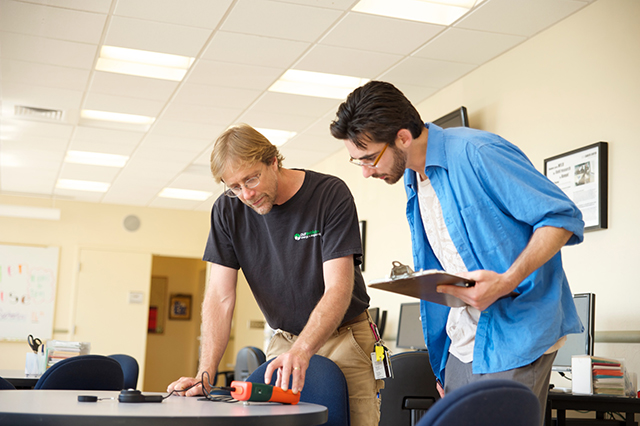
The report, which assesses emissions sources such as electricity, waste, transportation, and on-site fuel and natural gas combustion, has been shared with the CSU Chancellor’s Office and was publicly released earlier this year. Going all the way back to 1990, the report inventories human-caused emissions of the heat-trapping gases driving global climate change.
According to the inventory, HSU’s emissions today are below what they were in 1990. “This is due to a number of factors,” says HSU Sustainability & Waste Coordinator Morgan King. “Energy efficiency upgrades, public transportation programs, waste reduction and other sustainability efforts have definitely helped us achieve lower emissions. Some developments outside our control, though, like improved fuel economy for vehicles and statewide requirements for cleaner electricity have also played important roles.”
HSU is poised to join other CSU campuses in reducing its GHG emissions through the development and implementation of a Climate Action Plan, a planning and policy document designed to guide and prioritize emissions reduction measures moving forward. The CAP will align with the CSU Sustainability Policy, which calls for campuses to reduce their GHG emissions to levels seen in 1990, or below, by 2020, and to further reduce emissions to 80 percent below 1990 levels by 2040. Starting this year, the Office of Sustainability will be leading the development of the CAP for Humboldt State.
“We may be below 1990 emissions levels now, but if we continue on a business as usual course we might not reach our goal in five years,” says King. “There’s a real need to get the CAP off the ground, but before we do that we needed to know what the main emissions sources are and how big their impact is in relation to other sources. The greenhouse gas inventory was therefore a critical first step to creating a long term plan.”
The greenhouse gas report took more than a year to complete and included significant contributions from students in the Energy, Environment & Society (ENGR 532) seminar and the Sustainable Campus (ENVS 411) class, as well as interns with the Office of Sustainability.
“This was indeed a collaborative effort,” noted King. “We definitely relied on the skills and knowledge of our students to collect hard-to-reach data and to conduct much of the research and analysis for this report.”
Jesse Carpentier, an Economics major and intern in the Office of Sustainability, utilized responses from a 2014 campus-wide survey on commuter practices to identify emissions from students, faculty, and staff traveling to and from campus.
“Most survey respondents were driving alone to campus each day, instead of taking the bus, carpooling, riding a bike, or using some other alternative,” notes Carpentier. “Strategies that make it easier for people to drive less will be an important outcome of the CAP.”
The full HSU Greenhouse Gas Emissions Inventory Report can be viewed on the Office of Sustainability website, www.humboldt.edu/sustainability.